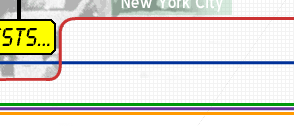



Generating Traffic: Robert Moses and New York City Road Growth || The Secret History of General Motors || "Does the City Exist for People or for Motorcars?" || A Spiral Unto Death
General Motors and You:
An Appreciation of James Klein and Martha Olson's "Taken for a Ride"
by Jill Rapaport and Scott Butek
The United States would be a very different place today if not for the interventions of a company called General Motors in the early part of the Twentieth Century, according to James Klein and Martha Olson in their stunning documentary "Taken For a Ride" (New Day Films). In a coup the magnitude of which can be fully appreciated only in historical hindsight, General Motors, recognizing early that there was a potential goldmine to be had if they could only wrest control of American transportation from the companies operating streetcars and trolleys, architected the destruction of both the infrastructure of public transport and the actual vehicles themselves, burning them in lots so that no bridge to the past would be left standing when the smoke had cleared. Americans would ride in cars, GM declared, and what was good for GM was "good for the country."
The film opens with a Jetsons-like industry cartoon from 1957, showing the gliding cars and skyborne roads of an imagined future. It cuts to a scene of traffic on a southern California freeway, choked and polluted, reminiscent of Godard's "Weekend" before the carnage starts. Interviews with carpool participants reveal that they spend more time with their commuting partners than with their families. They are stuck in cars for hours every day.
The angle of the film is provided by the writer and historian Brad Snell, who for sixteen years at the time of the film's making has been writing a book about General Motors. As Snell explains, GM is the largest corporation in the world, with sales of $125 billion a year, and operations in 104 countries. GM brings in revenues that make it the equivalent of the sixth-largest country in the world. But, as Snell points out, there is no written history of GM.
GM remains the particular focus of the film, which delves into the spectacular undertakings of the company throughout the better part of the twentieth century. Those activities ultimately drew the attention of the Justice Department, resulting in a guilty verdict against it, and GM's conviction on criminal antitrust conspiracy charges.
In 1922, only one in ten Americans owned an automobile. The rest used public transportation, which, in the first half of the century, consisted principally of the street car. While today automobiles are predominant in America, things were very different in the early part of the century. Back then, the street car was the norm. ("They were the best form of transportation," an interviewee enthusiastically and nostalgically declares in a series of brief interviews with people who remember the old mass transit systems.) Street cars were roomy and open; people read their newspapers while traveling to work, and were able to get to know their neighbors; the street car fostered a sense of community among Americans. This, as contrasted with the choked freeways and increasingly widepread outbreaks of road rage characteristic of contemporary U.S. society.
Enter Alfred P. Sloan. Chairman of GM from 1923 to 1956, Sloan saw the potential of luring to automobile use the ninety percent of Americans that were using public transportation, thus furthering his company's expansion. He set about effecting the deliberate elimination of what he called the rail "alternatives," and creating a new market for cars. Sloan's skills at verbal sleight of hand were apparent in the way he skewed the terms of discourse, calling rail the "alternative" and bestowing supremacy of place upon the car, which of course had come afterward, complete with logistical problems and incapable of addressing the public policy need that GM claimed it met.
The irony was that the automobile was a poor product, and the car culture that supplanted rail transit a disastrous step for the country.
Getting rid of the street car, Sloan believed, would make space in the streets for automobiles. His plan was to "motorize" all of the cities, so as to make them accessible to private cars. What this meant in reality was removing viable options for the ridership: replacing street railways with buses, on the clever assumption that people would not want to ride the buses, with their noxious fumes, erratic service and general low comfort levels, and, with no alternatives left, might be caused eventually to turn to the alternative of buying automobiles. Sloan and the other GM executives knew perfectly well that the clear popular preference was for the streetcar. They had figured out that if they could manage to render public transportation completely undesirable, the car would ultimately win. Accordingly, they ran massive public relations campaigns designed to indoctrinate the public with the idea that cars were what people really wanted after all.
If not for Alfred P. Sloan and his corporate partners, the landscape of America might be quite different from what we have grown up with. Under Sloan's direction, GM put a highly effective strategy into operation. The corporation began buying up shares in the largest bus operating company in the country, Omnibus, and the largest bus production company, Yellow Coach. Having thus created a foothold for itself, GM moved into Manhattan (selected because of its focal status in the shaping of national opinion), and acquired an interest in New York's railways. GM was soon the majority owner, and moved easily and swiftly to dismantle and eliminate the competition. Between 1926 and 1936, thus working behind the scenes, GM methodically destroyed streetcar transportation in New York. When the objective of motorizing New York City had been achieved, GM issued nationwide advertisements celebrating "the most important event in the history of community transportation". GM was seeking to convince the public that motorization was the wave of the future.
In the 1930s, GM worked to create the impression of a national trend away from rail transportation, by, among other things, releasing films for public consumption featuring claims like "Another city of 100,000 follows the national trend." The trend, such as it was, was entirely manufactured by GM itself.
The means to GM's corporate end, as "Taken for a Ride" makes abundantly clear, was the wanton destruction of public transportation. The company moved in and began to take over and destroy the entire industry, from the companies building the public transportation infrastructure (railcars, track lines, etc.) to those which ran the street cars.
How did such vandalistic abuse of the public interest occur?
The central instrument in GM's secret maneuvering was National City Lines.
National City Lines was founded in 1936. The company was to outward appearances a small family business. The ostensible founders had no apparent connections to GM, and were painted for public marketing purposes as having made it big on their own. In reality, they were not the founders at all. Greyhound and Yellow Coach, two GM subsidiaries, were. GM had from the beginning groomed the smaller company for its pivotal, though puppet role in the massive takeover of American transportation. The director of operations of National City Lines had originally worked for one of GM's subsidiaries, Yellow Coach. The members of the Board came from Greyhound, and the startup money from Greyhound and Yellow Coach.
To hide these unseemly connections, the company needed a front man. It found him in Roy Fitzgerald. GM would groom him to become head of NCL. In on the National City Lines venture along with GM were Mack Truck, Firestone Tire, Standard Oil of California and Phillips Petroleum. Together, these giant companies owned the majority shares of National City Lines.
National City Lines decimated the public transportation systems of more than eighty American cities.
Jim Holzer, a street car worker of the time, describes how it happened in Los Angeles. He describes the men in fancy clothes showing up, the rumor that "we [were] being bought.... The Fitzgeralds came in like they did in any other city they came into in America.... They destroyed an established public transportation system built to meet the needs of the people." Asked how long it took for National City Lines to get rid of the streetcars, he replies: "Ninety days."
Barney Larrick is introduced. Now an old man with chilling eyes, he was once the manager of operations for National City Lines. Larrick calmly tells an interviewer his side of it.
"Weren't the streetcars making money?" the questioner asks.
"Not after I got done chopping heads off, they weren't making money," comes Larrick's unexpectedly blunt reply. He talks about his method: "Reduce service . . . make it less attractive to the customer. . . . sell off property and holdings . . . take the money out . . . raise fares . . . suck the company dry. . . . Pull the company down. That's what [we] did."
The questioner presses him on why he fired people.
Larrick shoots back, "If you don't need the people what do you do? Keep them around for flies?"
The film goes on to describe the way in which GM created the modern-day institution of the Washington lobby, by spending unprecedented sums to hire an army of full-time influence peddlers, charged with the mission of convincing elected officials to invest public moneys in the creation of a national highway system. In effect, GM's campaign siphoned taxpayer dollars away from the community-oriented, popular favorite, the streetcar system, toward the building of auto and highway infrastructure, which profited a narrow corporate group at the expense not only of the public interest but of the environment, civil democracy and the wallets of ordinary Americans.
The result: New taxes (including the gas tax, to pay for the National Highway Fund); and a new governmental bureaucracy. The recently elected president, Dwight D. Eisenhower, appointed members of GM's Board to key governmental positions; those appointees in turn declared the building of highways a matter of "national security."
Finally, in cities like San Francisco and Boston, there were eruptions of public resistance to new highways cutting through urban centers, destroying neighborhoods and communities. Mayor Joseph Alioto of San Francisco describes being approached by members of then-Governor Ronald Reagan's administration, who were requesting permission to cut the highway through the city, destroying the famous waterfront district so that highway users could save "fifteen minutes" of motoring through the streets. Alioto said no. He suggested instead that drivers "slow down and enjoy this beautiful city." His fierce and principled stance reflects perhaps the mood of the late 'Sixties and early 'Seventies, when people were more likely to demonstrate for their rights than in the decades before and since. San Francisco presented a case in which a strong mayor backed by public protest stood up to the highway lobby. The San Franciscans won their showdown.
This led to hearings in Congress. At the time, federal funds for transportation had to go to highways, and could not be spent on public transportation. Auto and highway lobbyists made sure the laws were written to benefit their industries. People protested, and in 1974, Congress finally allowed cities to choose to have portions of federal funds directed toward public transportation. The victory was short-lived. The film ends by reporting that today, 90 percent of funds for research into transportation goes into development of "smart cars" that drive themselves, and highways and infrastructure (satellites, global positioning systems, etc.) to support these cars, rather than returning to the exploration of providing mass transit "alternatives."
Back to top